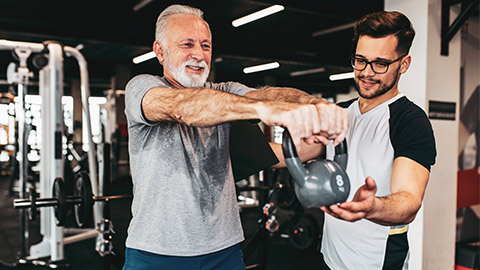In this topic, we look at what is involved in preparing to train a client. As well as the key responsibility of working safely and ensuring the safety of your client there are other responsibilities. Being a personal trainer carries a responsibility to ensure that the information you are providing is accurate and appropriate for each individual. You will learn about:
- consultation and documentation
- the role of spotting
- the NAMEDCAT model for monitoring a client's program.
Terminology and vocabulary reference guide
As an allied health professional, you need to be familiar with terms associated with basic exercise principles and use the terms correctly (and confidently) with clients, your colleagues, and other allied health professionals. You will be introduced to many terms and definitions. Add any unfamiliar terms to your own vocabulary reference guide.
Activities
There are several practical activities in the topic and an end of topic automated quiz. These are not part of your assessment but will provide practical experience that will help you in your work and help you prepare for your formal assessment.
Let us get started!

Your responsibilities as a personal trainer
Being a personal trainer carries a responsibility to ensure that the information you are providing is accurate and appropriate for each individual, with the safety of your client and other members of the gym at the core of all you do.
Remember you will work with a wide range of people from different backgrounds. Within the general population you will interact and work with people who may include:
- People of all ages, including senior citizens
- People of all genders
- People from different cultural, language and social backgrounds
- People who may have limited English language, literacy, and numeracy skills
- People with disabilities (including sight, hearing, mobility, intellectual).
This means that a personal trainer must not discriminate on the basis of ethnicity, culture, impairment, language, age, gender, sexual preference, religion, political beliefs, or status in society. It also means adjusting a programme and your communication skills when appropriate. You must demonstrate an awareness of culturally appropriate practices when interacting with a client. New Zealand is culturally diverse and practices may vary depending on the cultural background of your client.
You need to observe clients carefully as they perform each exercise, monitor their HR (heart rate), and RPE (rated perceived exertion) using an RPE scale which measures the intensity of the exercise. The scale runs from 0 - 10. Safety needs to be at the forefront of your mind at all times!
The consultation is an opportunity for a personal trainer or coach to get to know the client better and figure out their values, beliefs, and goals. The best way to gather the client's background information is by asking open-ended and closed questions.
- What objectives do you have?
- Tell me about your experience of visiting a gym
- What are your expectations for a program designed to increase strength?
- What type of exercise activities do you enjoy?
- What are your top three goals?
- Is increasing your muscles your key objective?
- Have you ever attended a gym before?
- Do you have any physical conditions that affect you using weights or other equipment?
- Have you ever used a rowing machine?
Open and closed questions help you to:
- gather detailed medical and exercise history
- create specific and measurable goals
- determine any weaknesses/barriers to exercises.
Documentation
You will be required by your gym to complete documentation recording the consultation. These are sometimes called screening forms. Each gym will have its own paperwork and processes for recording and filing the records. Confidentiality and client privacy is important so make sure any completed paperwork is stored safely.
Look at the REPS Pre-screening form which is approved by the New Zealand Register of Exercise Professionals. You can see it has the following sections:
- Important medical information,
- A diagram to label areas of the body that may be adversely affected by exercise
- Programming information including exercise goals, exercise history, client availability
- Monitoring progression
- Proposed schedule.
You may wish to download this document for future reference and explore more of the REPs has to offer at the NZ Register of Exercise Professionals website.
Regardless of the client, there are two key methods that combined will help you ensure you have competently met your responsibilities as a personal trainer. These are the:
- Spotting checklist
- NAMEDCAT model.
Let's look at both.

Spotting refers to supporting another person during a particular exercise, especially weight and resistance training.The emphasis is on supporting the individual to lift or push more than they would alone, safely!
Exercises that require a spotter typically include those where the lifter is under the weight and using free weights such as a barbell, dumbbell or hand weights. A spotter may not be necessary if the client is lifting machine weights as you could reduce the weight if necessary, however, checking technique and providing feedback
The spotting checklist
The spotting checklist identifies the following points as best practice spotting:
- Know proper exercise technique and give feedback on form.
- Know proper spotting technique (i.e. spot at wrists or elbows depending on the exercise, don’t spot the squat if using cage).
- Be sure you are strong enough to assist the lifter with the load being lifted or get help.
- Know how many reps the lifter intends to do.
- Be attentive to the lifter at all times.
- Stop lifter if technique is incorrect or they break form.
- Know a plan of action if an injury does occur (hope for the best, plan for the worst!).
The following table provides additional guidance about spotting related to cardiovascular work, resistance training machines and free weights.
| Training | Hands on interaction |
|---|---|
| Cardiovascular work | The personal trainer should be in a position to monitor clients HR and RPE and give any assistance that is necessary |
| Resistance training machines | The personal trainer should focus on ranges of motion, feedback on speed of movement, verbal cues, and hands on kinaesthetic feedback |
| Free weights | The personal trainer should be ready to assist if client is unable to maintain good form or unable to complete a rep and should spot from the wrists with upper body pushes. |
| Core work | The personal trainer should assist with form, breathing, feedback around ROM(range of movement/motion) and so on. etc. |
| Stretching | The personal trainer should direct appropriate stretching progression at end of session, within context of the workout and based on client need. |
| Balancing equipment | The personal trainer should be properly positioned to prevent the client the client from falling or provide adequate support for the client during balance training drills |
The NAMEDCAT ( also referred to as NAMSET) method has been developed by the fitness industry to help trainers monitor a client’s program and provide advice and direction as required. It is a logical and sequential approach to teaching resistance to a client and is the model you will learn and use throughout this Module.
| Step | Acronym | Description |
|---|---|---|
| Step 1 | N | Name the exercise. The trainer names the exercise, for example, 'This exercise is called a wall squat'. |
| Step 2 | A | Name the area of the body being worked. The trainer points out the areas the exercise targets. For example, 'This exercise uses your legs primarily but also incorporates your back, hips and your core for stability'. |
| Step 3 | M | Name the muscles being used. The trainer provides more detail by naming the muscles used. For example, 'This exercise primarily focuses on your quads and glutes, but will also rely on your hamstrings, lower back, and abdominal muscles'. |
| Step 4 | E | Set up the equipment for the exercise along with ensuring the body is in the correct position to perform the exercise. |
| Step 5 | D | Demonstration by the trainer/coach. The trainer then demonstrates the exercise so the client/ learner can see. |
| Step 6 | C | Coaching points are provided by the trainer to the client. The trainer guides the client through the exercise as they perform it themselves, giving cues where applicable to ensure proper technique and safety maintained. |
| Step 7 | A | The trainer considers alternative exercises or variations for the client/ learner. |
| Step 8 | T | Targeted stretches performed at the end of the session. |
The following video shows a personal trainer using the NAMSET teaching method to teach a group of clients the full press up exercise. Note that the personal trainer starts with naming and explaining the exercise including the muscles that will be targetted before he demonstrates the exercise. This video provides a fabulous overview of how to implement the coaching tips within NAMEDCAT/NAMEST to support clients safety and education, as well as a fun session.
Is there anything you would do differently?
According to the New Zealand Institute of Health and Fitness:
- There are around 300-360 club operators across New Zealand
- Today personal trainers can be found running personal training studios, home-based businesses or outdoors-based personal training businesses.
- Turnover in the industry is estimated at around $160 million although some of the latest estimates put turnover at around $250 million
What do they have in common? Even if the personal trainer is not based in a gym or club, they will all be using equipment, coaching clients, and demonstrating exercise techniques. This means they will all have a strong understanding of safe and effective gym techniques.
Why is safety so important?
When we think of safety, we often think first of the obvious safety issues in a gym. For example, related to the exercises, such as trying to lift too much weight, overdoing a workout, or stretching incorrectly. But your responsibilities as a personal trainer also include safety aspects such as:
- Infection control and personal hygiene
- Risk assessments
- Fire, evacuation and emergency procedures
- First aid.
It also means being aware of any policies and procedures and legislation related to safety in a gym or other environments where you are working as a personal trainer. Spotting and the NAMEDCAT model are two ways of working safely.
Watch the following video for nine tips for working safely in the gym, including knowing your equipment (and client), wearing the right gear, keeping the gym tidy and reporting hazards such as broken equipment, unsafe behaviour or spillage.
What do you know about safety procedures?
How much do you know about safety procedures in a gym? Would you know how to perform CPR if required?
In this topic, you looked at your responsibilities as a personal trainer. As well as the key responsibilities of working safely and ensuring the safety of your client there are other responsibilities. Being a personal trainer carries a responsibility to ensure that the information you are providing is accurate and appropriate for each individual. You learnt about:
- consultation and documentation
- the role of spotting
- the NAMEDCAT model for monitoring a client's programme.

